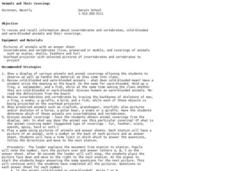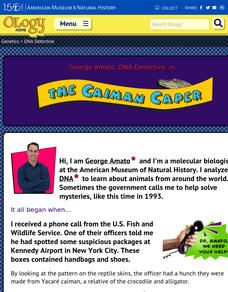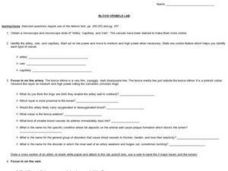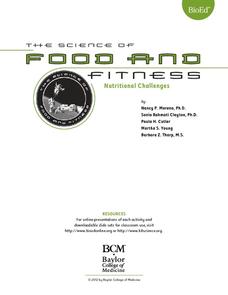Curated OER
Modus Operandi
In this fingerprint worksheet students complete a worksheet on their physical attributes and place their fingerprints on the paper.
Curated OER
Microviewer
In this microviewer worksheet, students observe several types of cells. Kids draw each type of cell and label the important parts. Students also answer questions relatable to the cell and the purpose for study.
Curated OER
Animals and Their Coverings
Students investigate the coverings of vertebrates and invertebrates and cold-blooded and warm-blooded animals. In this animals and their coverings lesson plan, students observe displays of different animals and discuss and answer...
Curated OER
The Human Body
In this human body worksheet, 6th graders respond to 13 different questions related to parts of the human body. First, they determine how many times the heart beats a minute and the 2 types of blood vessels. Then, students describe the...
Curated OER
Circulatory Systems
Excellent diagrams, labels and summaries make this resource be valuable to your students throughout the topic of circulation. All types of circulation vessels are explained, their structure and function is detailed, and the overall...
Baylor College
Activity and Exercise
Leave it to the classic jump rope to get your class excited about physical activity! Your class will begin by discussing the benefits of jumping rope as a form of exercise and learning a few different types of jumps. Then in groups of...
Curated OER
Jeopardy Game - Animals
Here is a fantastic Jeopardy-style game for elementary schoolers that's all about animals. This is one of the more thorough of this type of presentation.The 53 slides cover all sorts of topics about a variety of animals. There is an...
Curated OER
Reptile and Amphibian Word Search
In this reptile and amphibian worksheet, students complete a word search puzzle by finding 24 terms associated with the different types of reptiles and amphibians.
Curated OER
Genetics Since Mendel
In this biology worksheet, 9th graders determine whether it is possible for two alleles to produce four genotypes. Then they state how many alleles there are for blood type. Students also determine which blood type is inherited by...
Curated OER
Circulatory System
The ciculatory system is introduced here by means of clear, labelled diagrams and charts with details. After learning the basics of the heart strucure, a sequence of slides help show the flow the blood as the heart muscle contracts. A...
Center for Technology in Teaching and Learning
CSI: The Experience - Family Forensics
Forensic scientists depend on their observation skills to analyze evidence down to the molecular level. Middle and high schoolers practice making observations and predictions with a series of crime scene activities, which includes a...
Serendip
Homeostasis, Negative Feedback, and Positive Feedback
So many bodily activities depend on homeostasis! Give learners a solid background to understand the basic process of the human body. Scholars first examine negative feedback loops contributing to body temperature regulation and then a...
Curated OER
Turtle Talk
Young scholars watch a Powerpoint Presentation about turtles. They explain that there are 3 types of turtles and where each type lives. They describe a turtle's body and state some things that turtles eat.
Curated OER
Tissues
Complete with teachers' notes for most of the slides, this is a tremendous presentation of the four types of tissues: epithelial, connective, nerve, and muscle. Each is displayed with pertinent vocabulary and photos of microscope slides...
Curated OER
Reptiles and Amphibians
Introduce your class to various reptiles and amphibians. They will meet and identify a representative from each of the four major reptile families, then learn about and discuss reptile characteristics. Next, they will identify and...
American Museum of Natural History
DNA Detective
Match up the DNA code. Pupils read the website from the American Museum of Natural History about how DNA can determine whether a skin is from a particular type of reptile. Using the same technique, learners match up products with the...
Curated OER
Blood Brothers
Students study the blood characteristics of a number of distinct racial/ethnic groups. They build skills in observation, information gathering and processing. Students experiences strongly reflect the nature and intent of the current...
Curated OER
The Muscle System
In this muscle system instructional activity, 9th graders identify and write the name of each type of muscle associated with the body part listed. Then they label the illustration of the leg showing which muscle contracts and which...
Curated OER
Amphibians Crossword Puzzle
In this biology worksheet, students complete a crossword puzzle with 24 questions about different types of amphibians and functions of their body parts.
Curated OER
Worm Interviews
Students identify types of worms. In this organisms lesson plan, students are shown slides of the different types of worms and take notes on each worm. Students answer questions about each worm.
Curated OER
Blood Vessels Lab
In this blood vessel activity, students compare microscope slides of arteries, veins, and capillaries. This activity has 43 fill in the blank questions.
Curated OER
Diving Whale Sculpture
Students identify two types of whales: toothed whales and baleen whales, and understand that whales come to the surface for air. Then they recognize that whales are mammals (they nurse their young and are warm-blooded). Students also...
BioEd Online
Nutritional Challenges
Eating healthy can be a challenge, especially for people with special dietary needs. After learning about standard nutritional needs for adults, learners take on the role of a dietician and work together to create a menu for one of the...
Science 4 Inquiry
Genetics, Genetics, and More Genetics: Exploring Independent Assortment and Non-Mendelian Genetics
Two individuals share 99.9 percent of their genetic codes, yet diversity is observed everywhere. Young scientists learn about diversity through hands-on activities and an experiment. They apply the concepts of independent assortment and...
Other popular searches
- Forensic Science Blood Type
- Blood Types Punnett Squares
- Blood Typing Lab Activity
- Teaching Blood Types
- Abo Blood Typing
- Blood Type Activities
- Multiple Alleles Blood Type
- Human Blood Type
- Blood Type Labs
- Blood Typing Punnet Squares
- Blood Typing Lab
- Science Blood Types

























